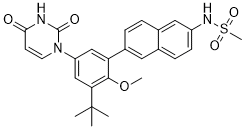This product is for research use only, not for human use. We do not sell to patients.

| Size | Price | Stock |
|---|---|---|
| 250mg | $710 | Check With Us |
| 500mg | $999 | Check With Us |
| 1g | $1500 | Check With Us |
Cat #: V3263 CAS #: 1132935-63-7 Purity ≥ 98%
Description: Dasabuvir (formerly known as ABT-333; ABT333; trade name Exviera, Viekira Pak, Viekira XR) is a nonnucleoside inhibitor of the RNA-dependent RNA polymerase encoded by the hepatitis C virus (HCV) NS5B gene. It inhibited recombinant NS5B polymerases derived from HCV genotype 1a and 1b clinical isolates, with IC50 values between 2.2 and 10.7 nM, and was at least 7,000-fold selective for the inhibition of HCV genotype 1 polymerases over human/mammalian polymerases. Dasabuvir is an FDA approved antiviral medication for the treatment of hepatitis C. It is often used together with the combination medication ombitasvir/paritaprevir/ritonavir specifically for hepatitis C virus (HCV) type 1.
Publications Citing InvivoChem Products
Product Promise

- Physicochemical and Storage Information
- Protocol
- Related Biological Data
- Stock Solution Preparation
- Quality Control Documentation
| Molecular Weight (MW) | 493.57 |
|---|---|
| Molecular Formula | C26H27N3O5S |
| CAS No. | 1132935-63-7 |
| Storage | -20℃ for 3 years in powder formr |
| -80℃ for 2 years in solvent | |
| Solubility In Vitro | DMSO: ≥ 45 mg/mLr |
| Water: N/Ar | |
| Ethanol: N/A | |
| SMILES Code | CS(=O)(NC1=CC=C2C=C(C3=CC(N(C(N4)=O)C=CC4=O)=CC(C(C)(C)C)=C3OC)C=CC2=C1)=O |
| Synonyms | ABT333; ABT-333; ABT 333, Dasabuvir; Trade names: Viekira Pak |
| Protocol | In Vitro | In vitro activity: Dasabuvir is at least 7,000-fold selective for the inhibition of HCV genotype 1 polymerases over human/mammalian polymerases. Dasabuvir inhibits the polymerase enzymatic activity of genotype 1 laboratory strain enzymes (H77, BK, N, and Con1 strains), as well as enzymes produced from polymerase genes from HCV genotype 1-infected subjects, with IC50s between 2.2 and 10.7 nM. Dasabuvir inhibits replication of HCV subgenomic replicons in cell culture assays, with EC50 values of 7.7 and 1.8 nM against genotype 1a (H77) and 1b (Con1), respectively. In the presence of 40% human plasma, there is a 12- to 13-fold decrease in inhibitory potency, yielding EC50s of 99 and 21 nM for HCV genotype 1a (H77) and 1b (Con1) replicons, respectively. Kinase Assay: the inhibition of human and mammalian DNA polymerases was evaluated by Replizyme Ltd. (Heslington, United Kingdom). The DNA-dependent RNA polymerase activity for human RNA polymerases II and III was measured using polymerases present in a HeLa cell extract and DNA templates containing promoters specific for either polymerase II or polymerase III. α-Amanitin, a potent inhibitor of human polymerase II and a modest inhibitor of polymerase III, was used as a control. The reaction mixtures contained 20 mM Tris-HCl (pH 8.0), 20% glycerol, 100 mM KCl, 1 mM dithiothreitol (DTT), 0.2 mM EDTA, 6 mM MgCl2, and either 1 μg/μl pAdVAntage plasmid (Promega, Madison, WI) (for the polymerase III assay) or 25 ng/μl cytomegalovirus (CMV) promoter DNA (Promega, Madison, WI) (for the polymerase II assay). The reaction mixtures also contained HeLa cell nuclear extract (ProteinOne, Rockville, MD), 400 μM ATP, CTP, and UTP, and 16 μM GTP and [α-33P]GTP. The reaction mixtures were incubated for 1 h at 30°C, quenched with the addition of proteinase K, SDS, and EDTA, incubated for 30 min at 56°C, and then analyzed on a Criterion Bio-Rad 5% acrylamide Tris-borate-EDTA (TBE)-urea gel. The gel was dried and placed on a PhosphorImager screen for overnight exposure. The volumes of the product bands were measured, and the percent inhibition was calculated; IC50 values were calculated using the following equation: % inhibition = 100[I]/([I] + IC50). Cell Assay: Dasabuvir (ABT-333) is at least 7,000-fold selective for the inhibition of HCV genotype 1 polymerases over human/mammalian polymerases. Dasabuvir (ABT-333) inhibits the polymerase enzymatic activity of genotype 1 laboratory strain enzymes (H77, BK, N, and Con1 strains), as well as enzymes produced from polymerase genes from HCV genotype 1-infected subjects, with IC50s between 2.2 and 10.7 nM. Dasabuvir (ABT-333) inhibits replication of HCV subgenomic replicons in cell culture assays, with EC50 values of 7.7 and 1.8 nM against genotype 1a (H77) and 1b (Con1), respectively. In the presence of 40% human plasma, there is a 12- to 13-fold decrease in inhibitory potency, yielding EC50s of 99 and 21 nM for HCV genotype 1a (H77) and 1b (Con1) replicons, respectively. |
|---|
| Solvent volume to be added | Mass (the weight of a compound) | |||
|---|---|---|---|---|
| Mother liquor concentration | 1mg | 5mg | 10mg | 20mg |
| 1mM | 2.0261 mL | 10.1303 mL | 20.2606 mL | 40.5211 mL |
| 5mM | 0.4052 mL | 2.0261 mL | 4.0521 mL | 8.1042 mL |
| 10mM | 0.2026 mL | 1.0130 mL | 2.0261 mL | 4.0521 mL |
| 20mM | 0.1013 mL | 0.5065 mL | 1.0130 mL | 2.0261 mL |
This equation is commonly abbreviated as: C1 V1 = C2 V2
- (1) Please be sure that the solution is clear before the addition of next solvent. Dissolution methods like vortex, ultrasound or warming and heat may be used to aid dissolving.
- (2) Be sure to add the solvent(s) in order.




































